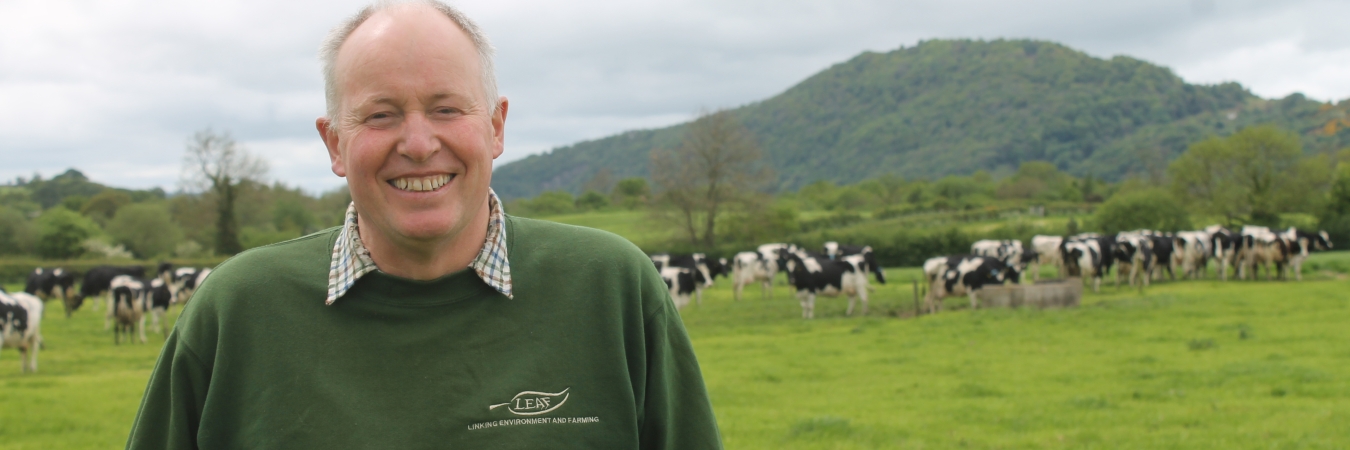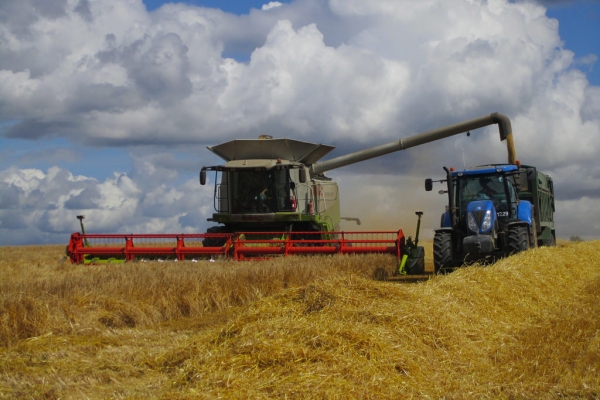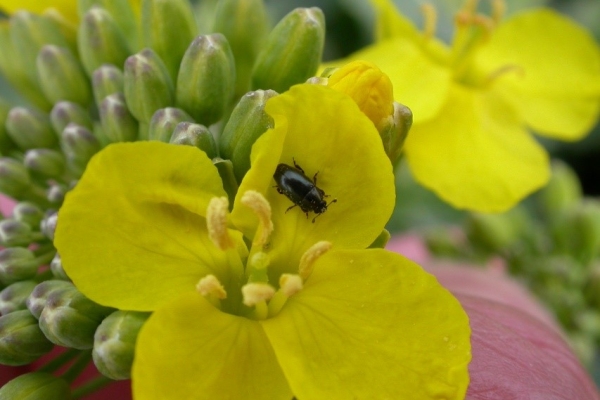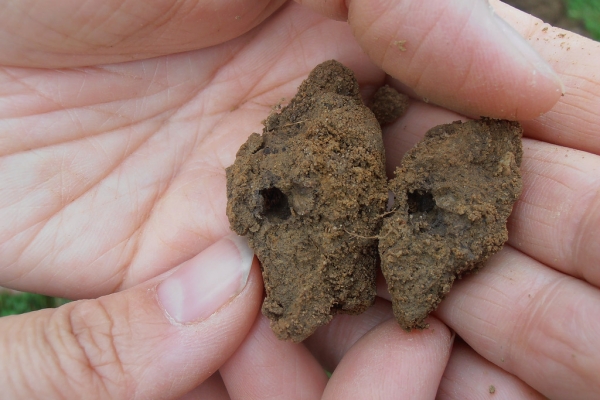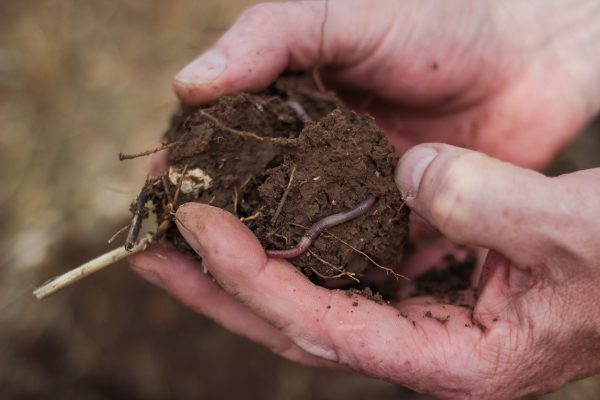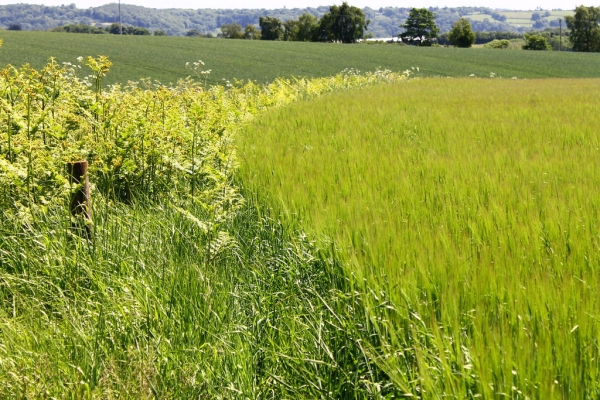Rob Kynaston
Great Wollaston Farm
Great Wollaston is a 242 acre mixed family farm on the edge of the Shropshire Hills on the English/Welsh border.
We grow winter wheat and winter barley and a mix of peas and spring barley for home use for our dairy herd’s forage, with any excess wheat and barley being sold off the farm. We have 96 dairy cows and usually milk 80 twice a day. All our milk is sold to Arla. The family have farmed Great Wollaston since 1921 and conservation has always been a priority but never seen to be in conflict with commercial farming.
Livestock – The key to a happy herd is to always put the animals first. We breed all our own stock which reduces the risk of disease coming onto the farm and improves traceability. Our dairy herd enjoy stress free conditions – we have good hygiene standards and pay careful attention to the amount of space per cow. Our paddock grazing system, where the cows are rotated around small areas of field, means they have daily access to lush, fresh grass. They spend a few days in each field before moving onto a new paddock, allowing the grass to regrow in the ones they have left, and return after 21 days. We see manure as a valuable resource; it is recycled back onto the land to improve soil fertility and structure. When the ground becomes too wet in the autumn the cows are housed in well ventilated sheds where they are fed grass, arable silages, a mixture of crushed home grown cereals and a small amount of bought in protein.

Crops for food – All of the crops we grow (wheat, barley and forage peas) are for feeding the cows. We have tried lupins for protein without much success. Growing our own feed crops means that we do not have to buy in specialist feeds which greatly reduces road miles. Sound crop rotations alongside appropriate seed varieties play a key role in our crop protection policy. 2 crops of winter wheat and 2 of barley are grown after grassland, then back again to growing grass, with clovers used to help fix nitrogen and to increase the protein content. (By including high rates of clover in grass leys, I have reduced the amount of fertiliser I use by more than 50%). We select high yielding grass seed with high soluble sugars to help increase animal production and we prioritise disease resistant varieties of cereal crops over them being the highest yielding.
Conservation – The farm is entered into Higher Level Stewardship, which means that most fields have a 6 m margin around them – a haven for field voles and shrews, as well as perfect habitat for a wide range of invertebrates. Skylarks, lapwings, finches, yellowhammers, barn owls, tree sparrows and hares are regular visitors to the farm, attracted by sensitively managed woodland, wildlife corridors, ponds and field margins. Overwintered stubbles are used to provide seed for birds during the winter months. In 2001, we won the English Nature and NFU President’s Award for Biodiversity, which enabled us to create a reedbed on the farm. This provides a diverse habitat for beneficial insects, birds and small mammals as well as helping with dirty water management. We also have a 60kw biomass log burner that produces hot water to wash the milking equipment and heat several buildings and is fuelled by coppiced timber from the woodland. We produce electricity from 20Kw of solar voltaic panels on the cow housing roof. Some is used on the farm, the rest goes into the National Grid.
Sustainability in practice
Managing water and trees to benefit the environment and the farm
We are unashamedly proud custodians of the countryside, conservation and farming go hand in hand. It’s all about looking at the whole farm and taking an integrated approach, from the way we look after our soil, our rotations, fertiliser use, through to managing specific areas of the farm for wildlife.
Reedbed – We have created a reedbed system to clean or ‘polish’ water draining from outside yards. There is a settling pool where suspended material can drop out of the water then a gravel bed in which common reed grows. The water passing through the gravel and the reeds take up the nutrients and also pass oxygen into the water which allows bacteria to break down the nutrients without depleting the soluble oxygen. The water then goes over a small weir to add more oxygen before joining the ditch.
This has cleaned up the ditch compared to when before the reedbed was put in, in 2002. The settling pool has to be cleaned out and the nutrient rich spoil is spread on the fields. The reeds have to be cleared each year or they would die and rot and the nutrients would go back into the water.
Pools – As well as the reedbed, the farm has 8 other pools which are fenced off from livestock and managed for wildlife.
We have hosted some training for species recorders from Preston Montford field centre on water boatmen (aquatic insects). The farm has 13 different species, one of which lives entirely in fresh cow pats!
We have also found great crested newts and signs of water voles. It is great to have these red listed species but we now need permission from Natural England to do any management around these pools.
Hedgerow tree pollarding to encourage livestock browsing

In days gone by pollarding was common practice; in the autumn branches were cut and thrown into fields for livestock to eat to fatten them for the winter. The timber was then used for building, fencing, tool handles or fire wood. The pollarded trees then grow more branches and after a period of time, depending on the species of tree and the use for the timber, the process was repeated. Some of the country’s oldest trees are pollards.
Providing fodder from trees is one way to mitigate livestock feed shortages. We have started to pollard some hedgerow trees, cutting off branches from about 2 m from the ground,. Beyond 2 m, it is too high for livestock to eat the new shoots. From trial and error we have found that we need to leave one good sized branch after pollarding to act as a feeder for the tree while it is growing new shoots and leaves. Once these get going the feeder can be cut too.
Woodland coppicing – We have been managing woodland coups (areas) for many years now. Coups are coppiced; cutting trees off at the ground to harvest the timber and allowing them to re-grow so that after a few years they can be re-cut, much like pollarding. These provide smaller timber up to 150mm in diameter. In the past we have used this material for making charcoal but now all the logs are used for the biomass boiler.
The coups are rotated within the woodland to enable a varying age structure and areas where all the trees are cleared, allowing sunlight to reach the woodland floor and encouraging ground flora to thrive until the trees grow back. The main tree we coppice is alder – which likes the wet ground of our semi natural ancient woodland ‘The Alders.’ Not all the woodland is coppiced; much is left to grow standard trees with an understorey of hazel, some of the large trees provide timber or veneer.
Motivations
Our farming philosophy has always been to define a clear goal and make lots of small steps in that direction. You don’t have to do one huge leap to get to an end point. It’s that vision of knowing where you want to be.

We recognise the importance of using less finite resources, and this is one of the main reasons why this is still a traditional mixed farm – growing most of what is needed to feed the animals on the farm. Arable crops are established using min-till techniques where possible. Compared with ploughing, it is quicker, uses less fuel, destroys less soil invertebrate and soil structure, and leaves more organic material near the surface to be easily broken down to humus.
We are proud that the farm is a LEAF demonstration farm. LEAF promotes Integrated Farm Management (IFM) which includes environmentally sustainable farming practices such as leaving wide field margins for wildlife, and informed and careful use of chemicals and pesticides (incorporating clovers in the grassland for example significantly reduces the amount of inorganic fertiliser, ammonium nitrate or urea that we need to use).
Each year we plant one to two large wild-bird feeding areas, half an acre in size, with a variety of seed rich plants that will provide homes and food for a variety of birdlife. The farm has had a number of surveys conducted on behalf of the RSPB and has provided a training base for recorders from Preston Montford field centre. We also work with Harper Adams, giving farm tours for their agricultural students and foreign visitors and providing support for their studies and surveys. In 2015 one of their post graduate students used the farm for a study on solitary bees.
Each year we participate in Open Farm Sunday, when we open the farm to anyone interested in visiting a farm. We are also delighted to welcome school visits and any other interested parties.
Farmer tips
- When fields with margins are down to grass/red clover leys, silage mowing contractors can cut the margins as well as the silage. To reduce complexity & confusion for contractors, you can surround fields with a 2m or a 6m margin, rather than mixing different margin widths in the same fields. Stakes with coloured tops can be used to mark the edge of field margins.
- Try to grow certain crops in the spring that will give birds like skylark & lapwing nesting cover.
- IFM is about making all the farm work together. A good crop rotation is vital – so you’re building up soil health & soil fertility & benefiting both the grass & the livestock.
- Growing your own protein feed pays dividends.
- Concentrate on farming areas that are productive, farm them well, & don’t try to farm the marginal areas that perhaps don’t give a very good return.
You can read Rob’s guest blog posts for LEAF here.
